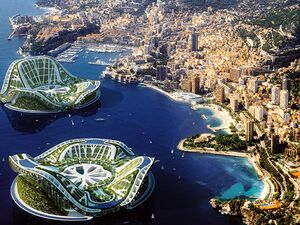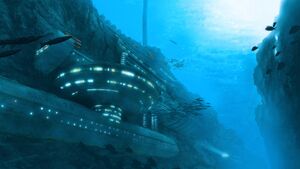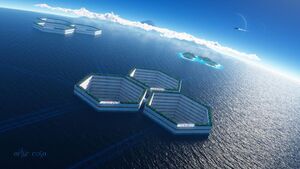Avalon Fleet Yards
Avalon Fleet Yards is the primary shipyard that services the Fourth Fleet. Located in the Grazer Sector within the trailing rimward section of the Alpha Quadrant, this base has long served as a production facility for starships of all kinds. While other starbases, such as Starbase Bravo provide support for the Fourth Fleet, this shipyard handles the most difficult and time-consuming refits that can't be accomplished at a standard starbase.
Facilities
Avalon Fleet Yards is a massive installation with orbital and planet-side facilities. The yard's headquarters and the living quarters for many of its staff are located on Avalon II. The primary orbital facility is Brahms Station, a Probert-class spacedock orbiting between Avalon II and its largest moon, which has been mined extensively for dilithium and has nearly been hollowed out to provide additional space for fabrication and assembly facilities. There are dozens of drydocks around the spacedock and the moon. Additional orbital stations provide research and design, storage, and additional accomodations.
Avalon II Facilities
Avalon II is a Class-O pelagic world with 95% of its surface covered in oceans. Highly unusual for a life-supporting planet, the seas of this world are almost entirely composed of heavy water, that is to say water that contains deuterium rather than hydrogen. While toxic to most carbon-based biologies, it is an important source of fuel for anti-matter reactors, and so Avalon II was initially colonized as a refining station. Floating deuterium refineries bob on the waves around one of the planet's only land masses, which also plays host to the fleet yard's shore facilities. Additional research stations are spread around the planet, both on and under the ocean's surface. There are several drydocks built in shallow areas that allow for the construction and repair of smaller starships capable of planetary landings.
Sato City
Named for early explorer Hoshi Sato, Sato City has a permanent population of 20,000, with housing space for up to 20,000 more transient personnel. Small by Federation standards, this town has all of the comforts one would expect from a Federation colony. Most of the fleet yards' long-term staff live here and take shuttles or transporters into orbit. The landmass here is narrow and rocky, snaking and branching in a way that creates deep fjords between its many peninsulas. This means that most of the structures are narrow and tall, including most of the housing—mainly single-family townhouses. There are a few parks created in the larger flatter areas, and in recent decades floating platforms have been placed in the small coves to provide additional space.
Deuterium Refineries
The planet's deuterium refineries are largely automated. Clusters of these refineries are connected by flexible but tough piping to bunkers on the ocean's floor. It takes many months for the refineries to fill up each bunker, at which point tankers transfer the deuterium to orbital storage facilities. Smaller quantities of deuterium can also placed in cargo shuttles fitted out as tankers from small landing pads at each refinery, and this is often done when ships in orbit need a top-off.
Research Stations
There are multiple research stations on Avalon II, studying the planet's unique ecosphere, mineral deposits, and other areas of interest. The higher density of heavy water means that those on the ocean floor must be specially reinforced. These facilities are run by a mix of Starfleet Science offices and civilian Federation agencies.
Ocean Dry Docks
Made out of concrete reinforced with titanium, several hexagonal caisson structures were built in the shallows near to Sato City. These facilities provide stable, flat surfaces for maintaining and constructing starships capable of planetary landings. Capable of being sealed with forcefields, these large structures can also be used for general storage when necessary. Starfleet has considered creating facilities large enough to construct explorer-type starships, but the resource outlay required to do so would be significant, as the walls of the caissons need to be thicker and thicker as they get wider to compensate for the pressure of the water.
Orbital Facilities
In addition to planetary facilities, Avalon Fleet Yards has a substantial orbital presence, anchored by a new Probert-class station constructed in the 2380s, in addition to free-floating orbital dry docks and smaller subsidiary stations.
Brahms Station
The centerpiece of Avalon Fleet Yards is Brahms Station, a Probert-class spacedock built in the 2380s to replace the Anchorage-class station that had originally been located there. Named for Dr. Leah Brahms, Brahms Station is capable of producing and maintaining starships of all classes and is the primary orbital habitat for personnel who do not live on Avalon II. In practice, this station most often builds frigate and cruiser-sized starships, while larger explorers are built and maintained at dedicated dry docks. It is also where visiting starships in need of only minor maintenance are serviced, to keep the dry docks free for more intensive construction tasks. It is also the primary defensive facility for the Avalon System, using its own substantial arsenal as well as a network of defense platforms to keep the fleet yard safe. The station itself is commanded by a Starfleet commodore, who reports to the admiral in command of the fleet yards.




